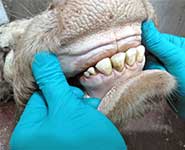The research by academics at the University of Bristol’s School of Veterinary Sciences, in collaboration with official veterinarian, Kevin Whiting, and supported by the English Beef and Lamb Executive (EBLEX), is published in the journal, Animal. The study analysed records for the age and stage of permanent anterior (PA) tooth development in a large population of current British cattle breeds and farming systems. The effects of sex and breed, and their interaction, on the age of tooth development were also assessed.
The research found that dairy-types moved through the transition points earlier than beef-types across all stages, intervals varied between eight and 12 weeks, and that collectively, native beef breeds moved through the transition points by up to three weeks earlier than the continental beef breeds.
In contrast to beef animals, the study found dairy females matured before dairy males. However, the difference between dairy females and males diminished at the later stages of development.
The research found differences between breeds. Across the first three stages, Ayrshires and Guernsey’s developed between three and six weeks later than Friesian/Holsteins and Simmental, Limousin and Blonde Aquitaine six and eight weeks later than Aberdeen Angus. Herefords, Charolais and South Devon developed later but by a smaller interval and Red Devon and Galloway showed the largest individual effect with transition delayed by eight to 12 weeks.
Professor Toby Knowles, Professor of Farming and Food Science in the School of Veterinary Sciences, said: “Changes have taken place in cattle farming within the UK over the last 30 years. These include the establishment of the popular continental beef breeds such as the Charolais, Simmental and Limousin, the widespread use of Holstein breeding in dairy units, and changes in feeding and management systems in both the beef and dairy industry. Yet no further large-scale studies have been carried out into the relationship between age and stage of permanent anterior tooth development during this period.”
The study involved a cross-sectional method and used a statistical model to analyse data gathered from animals slaughtered over a one year period from 2007 to 2008. The relationship between the number of PA teeth present and age was studied and the data set tested also for any differential effect between the sexes. Commonly represented breeds, registered as pure-breds, were further sub-classified and the model used to study the comparative age, breed and sex inter-relationships on stage of tooth development between dairy breeds and beef breeds and also to compare native beef breeds with continental beef breeds.
Data from 60,000 animals was initially analysed for age and sex effect. The age transition was found to be 23 months moving from zero to two teeth; 30 months for two to four teeth; 37 months for four to six teeth and 42 months for six to eight teeth. Males were found to develop, on average, 22 days earlier than females across all stages.
A reduced data set of 23,000 animals registered as pure-bred only was used to compare breed and type interactions and to investigate sex effects within the sub-categories. Breeds were grouped into dairy and beef-type and beef breeds split into native and continental.
Despite the changes in the popularity of certain breeds over the last few decades and changes in systems of husbandry, the overall effects on anterior tooth development have been small, although the research suggests a trend towards a slight delay in development across the first three pairs.
The research found breed, including collective types, and sex are shown to have an influence on development and should be considered in age estimation using PA teeth.
The study also suggests there will be further movement in breed profile over times as a result of changes in market demand. There has been, for example, increased popularity in traditional breeds such as Aberdeen Angus and Shorthorn since the data for the study were collected.
Paper: The anterior tooth development of cattle presented for slaughter: an analysis of age, sex and breed, K. J. Whiting, S. N. Brown, W. J. Browne, P. J. Hadley and T. G. Knowles, Animal, volume 7, issue 8, August 2013, pages 1323-1331.
